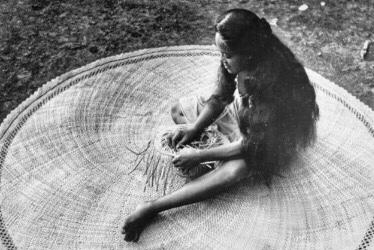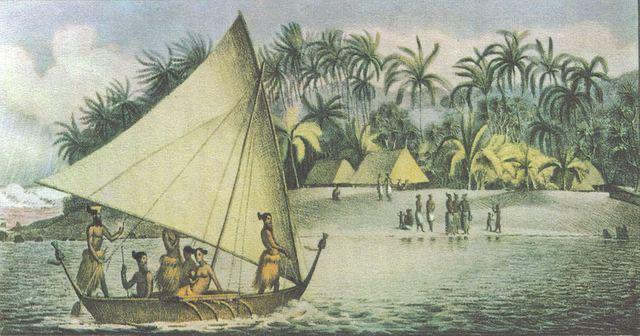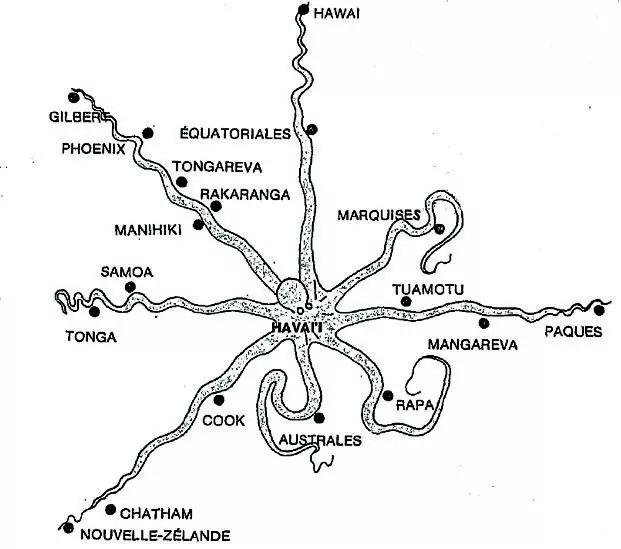The Legend of HINA: an Interview with Hinano Murphy

Hinano Murphy is public figure in French Polynesia, especially regarding the preservation and transmission of Polynesian culture, she is in charge of Gump Station’s and Tetiaroa Society’s outreach programs. She has also collaborated with the producers of Disney Movie Moana in order to preserve the integrity of the Polynesian natural and cultural settings. She’s currently working on documentary film on Polynesian ambassadors who would incarnate all the attributes of the Goddess Hina. Here Hinano unveils the meaning and strong message behind images and symbolism in the story of Ru and Hina. knowledge that was first handed down to her by her mother and now to you.
This creation myth has been used in different island groups of Polynesia. The legends usually feature Ru and tell the story mostly from his point of view, but according to Hinano’s mother, Hina’s role is much more important than the most recent versions tend to reveal.

« Ru and Hina set forth in their canoe to search for and create their island world. Ru sat in the back with his large steering paddle and had asked Hina to create the sails for the canoe she wove from pandanus leaves. »
This part of the legend has deep symbolism indeed the act of weaving is there to establish and record knowledge, similar to the act of writing. Hina when she weaves the sails for the canoe, she puts in order and combines knowledge from the spiritual, cultural, and natural world. She calls for Tane (god of Beauty, Craftmen and canoe Builders ) to be part of the journey, sets the winds, the clouds, the waves, the currents , and genealogy. She is also building strong alliances with people.
The sails ready, she helps Ru to install the mast and mainsail of the va’a (canoe). The mast is the link between Heaven and Earth, Spirituality and field of action of Mankind. Unity and balance is the key. Prayers to Tane asking him to give them permission and protection, asking for the ocean to give birth to life.

« Then as they sailed over the ocean Hina was sitting in the bow of the canoe, giving directions to Ru, and hailing the arrival of the islands, which he then named. »
Whatever gender you are, you have your seat on the canoe. Your role in creating a new Havaiki, a new world. This position of Hina in the bow staring at the vast ocean is an important image because she is showing us pathways to life. She is guiding the canoe. She knows that from her waters emerge life. She has to guarantee life for Rū who is sitting at the stern of the canoe. She is controlling the creation of this world. In the original versions the chants relate to the very delivery of a baby. With his big steering paddle he steers the canoe wherever Hina tells him to go. Together they are creating the Pacific Island World, each island – Vavau, Upolu, and Havaiki – has a role to play. The main objective is creating a new Havaiki as the new center of life, or goal/solution.

The Interview.
1. Hina is famous for her connection to the Moon, she ’s often called The Goddess of the Moon?
What do you think of this « title »?
Hina has many attributes all as relevant and important as one another. We as Women should keep in mind we are Hina, hina rere, hina tini, hina paarae, hina tau we are descendant of our parents. We are LIFE ourself. Here in our many stories, our myths, HINA is daughter of Atea and Fa’ahotu, she is sister of this only man with many titles as well Ru.
‘hina’ (grand-child,3rd generation), ‘hinarere’ (grand-child, 4th generation), ‘hinatini’ (grand-child, 5th generation) ‘hinapaarae'(grand-child,6rd generation), ‘hinatau’ (grand-child,7rd generation).
It seems that those titles were given in an particular order that we can consider as steps in our own life journey. Before being in the moon she was Hina-i-faauru-vaa. In this journey with her brother Ru, she is daughter of Atea and Fa’ahotu, she was asked to weave sails for their vaa.
Hina as the keeper of knowledge of spiritual, natural, and cultural world. She is in charge of weaving our spirit with spirit of all creatures of Ta’aroa (God of Creation), be one good entity. She calls everyone to join for this journey bringing strenght, protection, love and compassion to achieve this goal. Call for unity to weave this sail who will catch good winds, and move forward to acknowledge and to protect life. She is given the front of the canoe to stand, guide, help her brother. She inspires us Women to do so.
After exploring the Earth with Ru, Hina’s left her brother ashore and set off in her canoe to visit the Moon as it was rising up on the horizon. As she stepped into it she was so happy and she decides to stay there for ever. Then from Hina-i-fa‘auru-va‘a she became Hina-i-aa-i-te-marama protecting her brother in his travels on Earth and all wayfinders at night.
2. Hinatutuhaa is another name she goes by, refering to the making of tapa cloth.
Hina, and women, in general, were renowned for tapa Cloth making.
Why would women only make tapa cloth?
Well a very interesting question that I have asked many women making tapa cloth. It seems that and through many stories I was told, Women were the only one doing tapa. Men are involved in the rituals at certain steps, but it was given to Hina the role of beating the bark and shape it into a sacred cloth that will wrap, protect spirituality. What a great and hard work, an important responsibility for us Women. She is the moon and thus manages time and cycle. How could we look at this title of Hina.
I want to say, As a tree sustains and nourishes life, bark sustains and nourishes the tree. Bark protects the tree By managing time she shapes every living species, protect them, so they can sustain humanity. There is another aspect that is very important, there is a say in our community of tapa experts, you can give a piece of bark to any Hina, it would never become identical tapa cloth This rhythmic activity will create a unique piece of art that shows how people grow and change throughout their lifetime and how their unique experiences mold them and enhance their individuality .
3. How do you personally connect with her?
Are doing it on a daily basis or do you connect with her for a special event or need?
Connecting with Hina is a personal pathway that you take some times alone, sometimes in groups, some time with another Hina older or younger, just remember, we are all unique but we can all stand together in our diversity, with Peace, Aroha (love and compassion), Humility and the best of our inner soul to work for a common cause. Through chanting, dancing through stories, through upu, and so many ways life will give us the choice to experience.
4. We know you’re working on a Tv documentary about young Polynesian ambassadors who can be considered as today’s « Hinas ».
Which characteristics a « Hina » should have?
A Hina needs to:
Look for who she is
Gather knowledge
Weave good alliances
Share her experience and spirituality
Inspire the community be an ambassador of life
Stand for protection of humanity.
